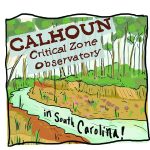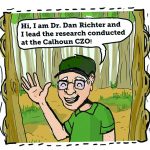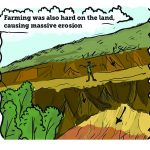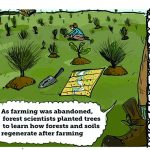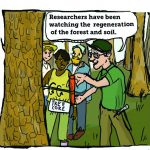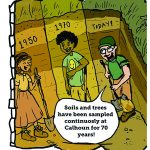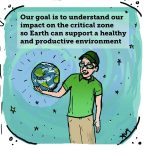Diego Barcellos’s Journey

By: Cynthia Adams
UGA DOCTORAL STUDENT DIEGO BARCELLOS is Brazilian-born and grew up on a 150-acre working farm. Now his past and future intersect as he studies soil science while the world grapples with climate change. Guided by UGA research professors, Barcellos studies two Critical Zone Observatories (or CZO) at locations in Calhoun, SC, and Luquillo, Puerto Rico, analyzing how iron minerals control soil carbon. Barcellos’s research investigates environmental conditions within these two very different locales.
Research outcomes determined here are of importance to farm production worldwide, including that of Barcellos’s farmlands. The Calhoun and Luquillo sites are among 10 others known to a broad range of scientists as critical monitoring sites. In essence, the lands comprising a CZO can serve as canaries in the mine for environmental changes and their impact for our planet. These factors underlie Barcellos’s doctoral research.
Diego Barcellos knew about the value of good soil from earliest memory. He came of age on a Brazilian coffee and cattle farm in João Neiva, Espirito Santo State. He produces snapshots of himself as a small-framed boy, working alongside his grandfather and siblings in the field. He is only six years old.
Prophetically, Barcellos is turning over soil as he works. Although Barcellos is young and slight of frame, his face is determined and focused as he tills. Behind him there is a mountain and woodlands. The vegetation in the background is green and the overturned soil at his feet is rich.
Soil, it so happens, would become important to his adult life and scientific career as a present-day soil scientist.
Poor soil, Barcellos explains, is the bane of productive farming, with snowballing effects. Depleted soil leads to crop failure. Crop failure is of immense significance on both micro and macro levels, with great consequence for the world food supply.
In the absence of rich, productive soil, it is impossible for farmers to produce successful crops and meet the world’s food needs.
Barcellos is deeply invested in farming, having descended from Italian immigrants that arrived in Brazil in 1885. Now he continues in the tradition of family farming—but in his case, as a scientist/farmer.
“So, I am of the fourth generation that owns that farmland,” Barcellos says. “We have been growing coffee for more than 50 years. Before that, it was mostly cattle, hogs, and subsistence farming. My father still raises dairy cattle together with coffee.”
As the family snapshot of the young boy at work in the field demonstrates, his face is a study in concentration as he hoes. “We worked at 4:00 a.m.,” he says. You can sense the heat and the fatigue of his grandfather.
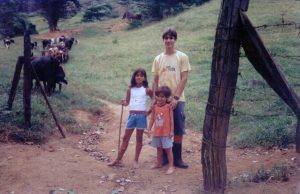
Courtesy of Diego Barcellos.
“I have been a work farmer,” Barcellos stresses. “And I did everything you can imagine. Growing up and seeing the difficulties of work on a farm, I was always interested. I believe to make an impact in the world and help agriculture, we need someone that has multiple skills and experiences that complement each other.”
An understanding of what agriculture demands begins from the ground up—the very ground beneath Barcellos’s young feet. Now, he is literally growing his own knowledge.
“Starting,” he explains, “by understanding well what farming is, and having lived this experience of working under the sun, like I did.” And then, he adds, “to have technical skills and know advanced technological ways of conducting research.”
The final aspect of his challenge, Barcellos says, is not so much about mastering science as self-mastery. “Finally, to have good social skills and to be a true and humble leader. That is what I am working on…all together.”

Barcellos (left), with Chunmei Chen, a postdoctoral scholar, and Aaron Thompson, a UGA professor in the College of Agriculture and Environmental Science.
A NEW AGE OF FARMING AND SCIENCE: “I want to turn my career into a mixture of the highly technical and managerial,” doctoral student Diego Barcellos explains. “I want to be a liaison between the farmer and the real world.”
His interest began while coming of age on his family farm in Brazil. Barcellos is most interested in transformative research that can potentially enhance food production and help ease global food scarcity. As CBS News reported a devastating impact to the world’s coffee production due to climate changes last September, Barcellos observed, “That is pretty sad news. Definitely it will impact millions of coffee farmers around the word. Including my family and the farmers from my region, where we have been growing coffee for decades.”
Harnessing a Childhood on a Coffee Farm to Become a Scientist
A century after the aristocrat writer Isak Dinesen dreamed of coffee farming in Nairobi, Josh Kilmer-Purcell penned a best seller, The Bucolic Plague, iterating the many ways his own dream of rural farming went awry. The NYC ad executive’s clumsy attempts to retreat from urban life and embrace bucolic bliss nearly unraveled. The book is good for a comic reveal—truth versus reality. But it is Dinesen’s rending account of coffee farming that reads truest and with heart-breaking starkness.
Barcellos has lived the stark realities of a coffee and cattle farm. When he read Dinesen’s comments, he said they were beautiful and reflected his father’s and grandfather’s experiences of coffee farming.
So he would have appreciated it when, during a Graduate School awards reception in late August, Graduate School Advancement Board President Lindsay Boring joked that “many a forestry student comes from a dairy background.” Boring directs the conservation, research and educational programs of the Joseph W. Jones Ecological Research Center at Ichauway in southwest Georgia. He is a botanist interested in environmental ecology. And yet, there was seriousness in Boring’s message.
“There is nothing harder than working with cattle and dairy,” Boring said afterward, sharing stories of his youth spent on the family dairy and days that began long before sunrise. “Yet, you love the outdoors, so forestry looks appealing.”
Barcellos, much like Boring, integrated similar experiences into his future plans and life work. Now, his research within two forests provides a framework for that work.
He has dedicated his studies to protecting farmlands and food supplies, each threatened by unsustainable practices. Barcellos says he is driven to meet the needs of an expanding world populace as soil grows less productive. His work builds upon his master’s studies in phytoremediation, which involved both a greenhouse experiment and field work in Brazil.
“I am interested in soil science, focusing in the sub-area of soil chemistry and biogeochemistry,” Barcellos explains. He considers the chemical interactions and stabilization mechanisms of soil carbon by iron oxide—which in turn, will benefit farmers.
“By better understanding the mechanisms of carbon and nutrient storage by iron and aluminum oxides, we can better manage soil nutrients and improve carbon sequestration in the soils,” he explains. “Moreover, a more profound understanding of soils is essential for achieving global food security.”
The composition of soil, its productivity, and the availability of topsoil, are approaching a global tipping point.
If that sounds extreme, consider this: According to Time magazine, experts reported in 2012 that the world is swiftly facing the loss of useable topsoil. The magazine reported on issues of soil erosion and degradation, stating that only about 60 years of topsoil remained—sounding a global alarm over four years ago.
“Some 40 percent of soil used for agriculture around the world is classed as either degraded or seriously degraded,” the report stated, citing the World Economic Forum. The article warned that farming techniques which strip the soil of carbon have rendered it nutrient weak and depleted. This encapsulates the gist of Barcellos’s research area.
Worse yet, lost soil is not being replenished, the Time’s article adds, “Even the well-maintained farming land in Europe, which may look idyllic, is being lost at unsustainable rates.”
For Barcellos, there are many incentives to intercede in this scenario, and become an actively engaged, hands-on researcher when he completes his doctorate.
“I want to turn my career into a mixture of high technical and manager,” he says. “I want to be a liaison between the farmer and the real world. My ultimate goal is to be a global leader in agriculture, farming, and soils issues, such as working for the Food and Agriculture Organization of the United Nations.”
Barcellos has oriented his life towards this: a worthy goal will mean work. “It is like a Formula 1 racer that dedicated his life for that since early stages, like Ayrton Senna from Brazil.” Senna himself once said, “I have no idols. I admire work, dedication and competence.”
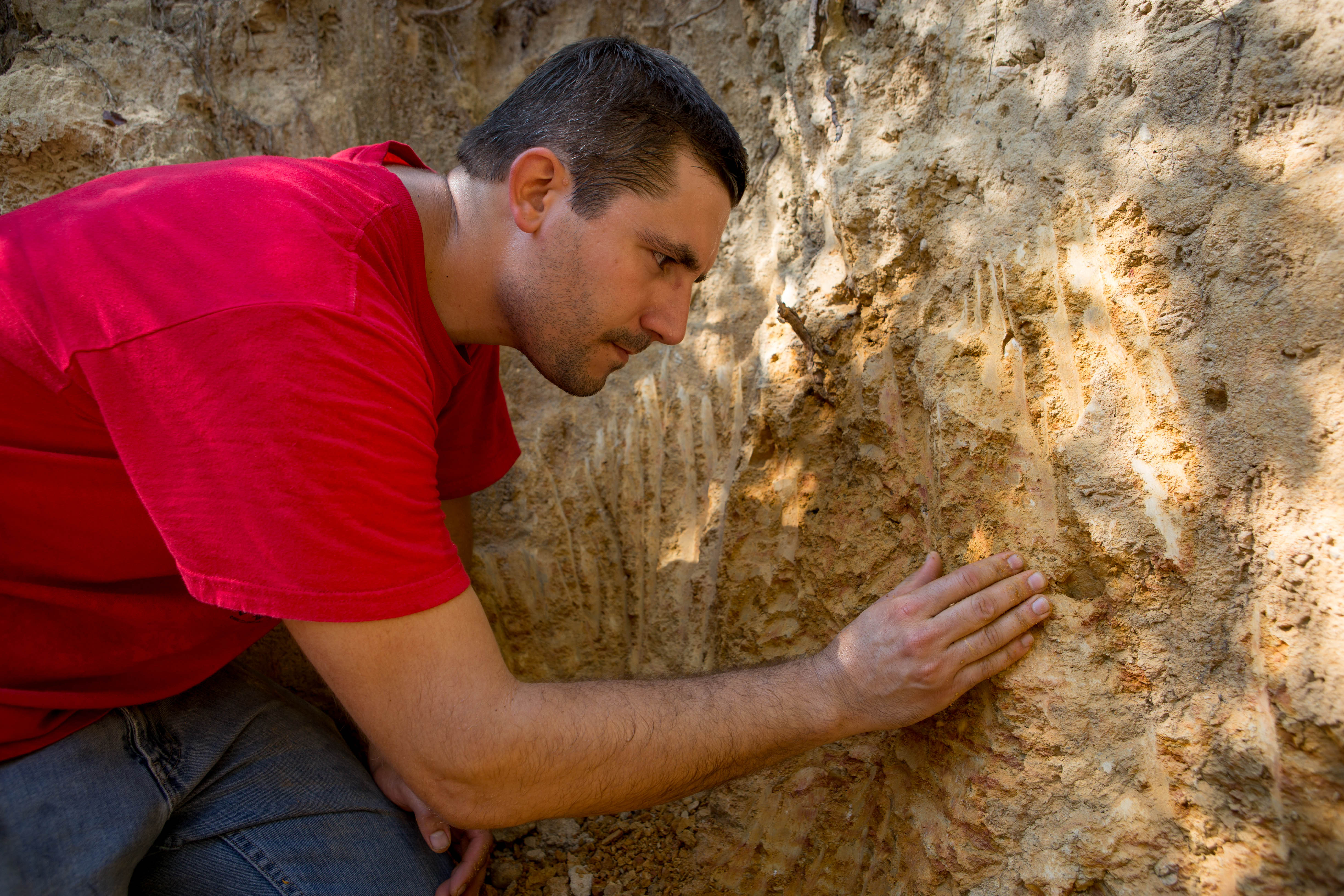
On The Trail of Lost Topsoil: Following the Sediment
After offers to study at four graduate institutions in 2012, Barcellos chose the University of Georgia.
One afternoon between classes, Barcellos described his current research at the Calhoun CZO. He has completed field work at the Luquillo CZO, having spent April through June last year onsite. “This is the legacy of abandoned cotton farms during the Great Depression,” he explained in discussing the Calhoun site. “Studying the area erosion in South Carolina after 70 or 80 years, we’re looking at regeneration and how it affects the soil.”
Calhoun lies three hours northeast of the UGA campus inside a federal park. These parklands now represent what was once an enormous farm, which has long since lain fallow but has been reforested. The Calhoun CZO originated as the Calhoun Experimental Forest in 1947, becoming a CZO in 2014.
Last summer, Barcellos travelled there with a group of fellow researchers on a smothering hot August day. One team is led by Aaron Thompson, a UGA professor in the College of Agriculture and Environmental Science, and another by Daniel Markewitz, UGA professor in the School of Forestry. Both professors have made significant contributions to Calhoun research.
Although the researchers departed UGA at 6:00 a.m., they returned late that night following a full day of soil sampling and probe placement. Through this work, they monitor moisture levels and gather other data within the parklands once maintained by the United States Forestry Service.
The site lies within a watershed, and Thompson says it was originally cleared for farming in the 1800s. Later abandoned, Calhoun was reforested in the 1940s.
To understand how its hydrology is affected, Thompson says they are “tracking the lost sediment.”
Colleagues from Barcellos’s lab include Thompson, who is his doctoral advisor, and Chunmei Chen, a postdoctoral scholar. They set to work without complaint despite oppressive conditions. They must first lug plastic tubs of data-collecting gear, spades, and miscellaneous equipment required for sensor placements both upland and down land inside the CZO.
Yet, the arduous physical work of preparing for data collection takes place in a nondescript and isolated patch of woods. To the untrained eye, the site is not especially welcoming, with the soil crumbly and sunbaked. There is little relief from the sun, apart from the shade afforded by a canopy of pines. The researchers tuck their pant legs into their boots and hoist loads of equipment they must port into the woods. It is challenging to make out the trails leading to their sites, which is by design to discourage vandalism.
The group will brave temperatures hovering in the 90s and the temperatures do not break. But then, neither does their good humor.
And, beyond the heat, there are other hazards: Steep terrain makes it hard to keep your purchase. Poison ivy thrives, and numerous felled logs and dry leaves offer ample cover for snakes. There is the ever-present menace of chiggers. The chigger, Thompson jokes, is an ongoing, sometimes weekly, reality.
The data-gathering probes they use monitor soil moisture and redox, which is the term for reduction and oxidation. Samples collected will be analyzed offsite, offering information concerning changes effected by factors such as erosion. The data captured, Thompson says, provides for molecular scale analysis that is in turn shared with other CZO researchers and scientists.
The Calhoun workday is long, the conditions are unforgiving, and despite applications of DEET, mosquitoes buzz and bite. But Barcellos and company are upbeat and set about working.
Everything Barcellos experienced as the child of a farmer, a child coming of age in a rural reality, influences him now. He has witnessed the cyclic reality of farming with all its potential failures. He is humbled and has been prepared by it.
“I did everything you can imagine. Growing up and seeing the difficulties of work on a farm, I was always interested in farming,” he explains.
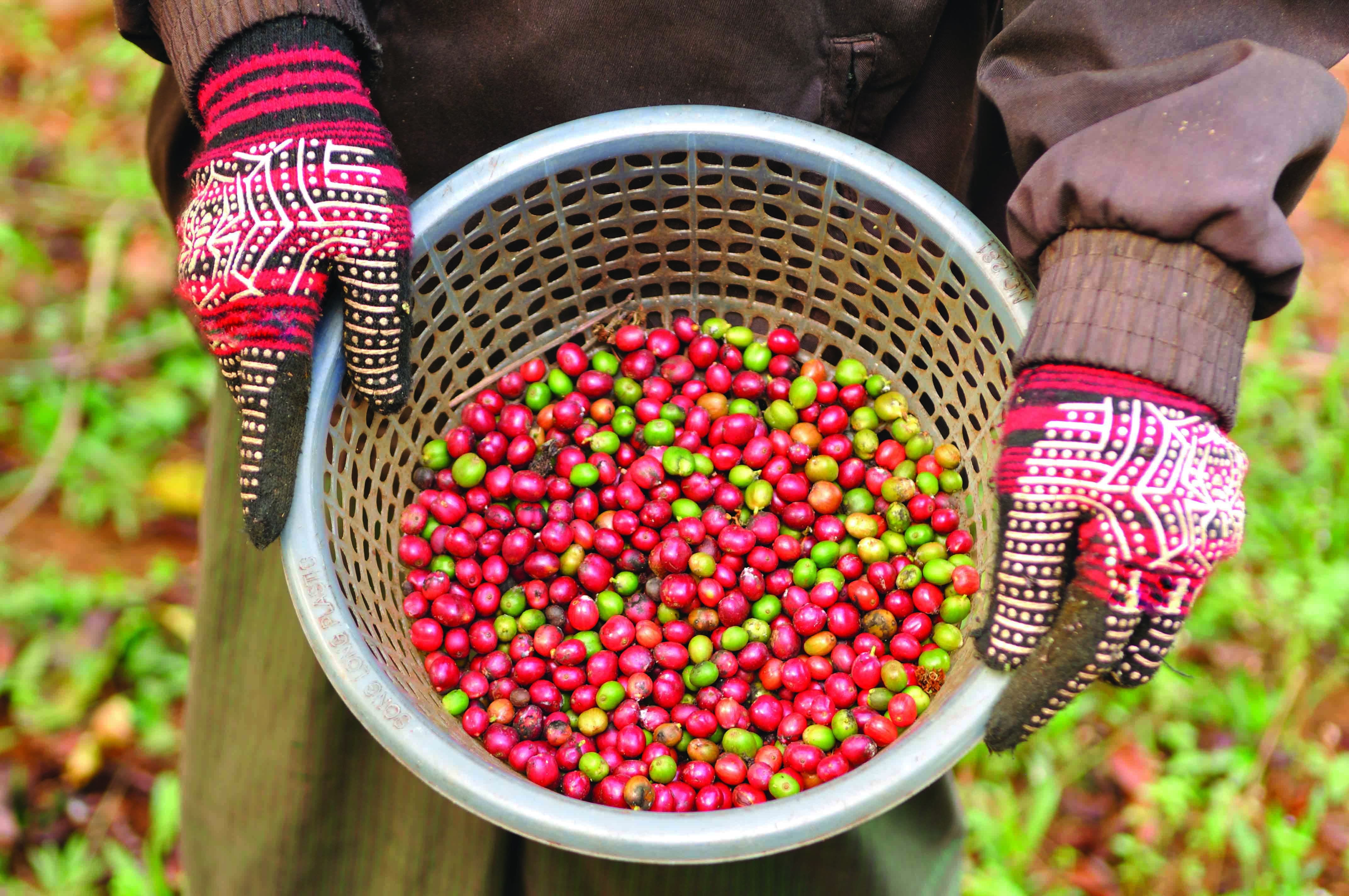
Diego Barcellos grew up on a Brazilian coffee and cattle farm in João Neiva, Espirito Santo State. He is descended from José Barcellos, who settled there in 1885. His great-great-grandfather immigrated from Italy to Brazil, during a time of agricultural decline for Italy when Brazil offered farmlands to immigrants.
When asked about his early education, Barcellos answers that he is “middle class, and attended public schools.” But Barcellos allows himself a small amount of pride when adding, “My father never had to pay for my education. I was a good student. And, I wanted to give back to the farmer.”
He studied agronomy in Brazilian universities before coming to Georgia for graduate work in the field of soil science. “It involves chemistry, math, biology,” Barcellos says. “It has a huge province.” He made a massive decision, having moved 4,657 miles from Brazil. However, his intention was always to use his education in order to advance the larger cause of farming.
So, despite temperatures pushing ever-closer to the 100 degree point in the shade, Barcellos is optimistic, joining with work that will pay off for farmers worldwide. Tracking and preserving the world’s precious topsoil is a powerful motivation.
In tracking Calhoun’s lost sediment, it is difficult to envision its past as productive farmland. Much of the topsoil has long since washed into a creek below the hillside that feeds into the Tyger River. (This, as Barcellos reminds, is the problem; most of the topsoil is being carried away.) These protected lands have been allowed to regenerate. And yet, the land remains degraded. Calhoun IS a known canary in the mine.
It starkly illustrates “some of the most serious agricultural land and water degradation in North America’s five themes: Eco-hydrological Recovery; Biogeochemical Decoupling; Erosioninduced Carbon Dynamics; Human-CZ Interactions; Dynamic Persistence of Alternative States,” according to the CZO website.
Barcellos crouches near plastic tubs of probes, tubing and equipment ported in by hand. “The general picture is this,” he explains. “The soil is the biggest terrestrial compartment for storing carbon. In storing and releasing carbon into the atmosphere as CO2 or CH4 , you increase the global warming. It’s the loss of carbon from the soil that is a very important mechanism.” He is studying the iron minerals that have a high surface area and can chemically bind a lot of carbon in the soil.
“A small amount of iron minerals can play a large role,” he explains.
The scientist must return periodically to collect data and check equipment in order for him to quantify what role iron minerals will play. Graduate researchers like Barcellos can add to environmental information that may influence public policy and further scientific knowledge in the wake of climate change.
What interests Barcellos more, however, is how the data can be applied to potentially devastating issues concerning soils. Soil depletion, he explains, is an escalating problem with devastating consequence. What he learns could have aspects that matter elsewhere, even continents away. “For example, in Africa,” he says, gesturing towards the array of monitors. “This helps me understand different environments, this equipment used for measuring things in the soil.”
Last October, Barcellos returned to Calhoun. He will repeat the work throughout the extreme winter months to come, as he constantly evaluates and re-checks sensors. Work that was brutally hot in summer gives way to bitter rain and cold.
Barcellos trusts the data will inform more answers. He shrugs. Life on a 150-acre farm has prepared him to be patient. “It’s not that hard,” he insists.
Then, he smiles convincingly. It is the same smile that Barcellos averted from the camera years earlier, standing on Brazilian farmland. There are echoes of the earnest young boy turning the soil as he prepares himself as well.
Later, Barcellos sends another snapshot of himself taken six years later, this time posing with younger cousins. Again, his chin is high and his gaze is confident and direct. Barcellos is the tallest of the three, and his dark eyes are mature beyond his years.
“I was probably 12 or 13 years old,” Barcellos explains, saying the snapshot was also taken when working with the cattle. “It was probably 8:00 a.m., and I had finished milking the cows, so I was taking them to a pasture, as you can see in the photo.”
His was, and remains, a hopeful smile—one ripe with promise.

Courtesy of Diego Barcellos. Circa 1993 on the Barcellos farm, right to left: “My grandfather, Dionizio, my sister, Diana, and my cousin, Icaro. My sister and cousin were three years old. I am the tallest kid, far left, in the striped t-shirt. I was then six years old. This photo means a lot to me. It shows my grandfather teaching us, since we were very little, how to work with the farm, to give importance to our job, and to be responsible with work.”
What are Critical Zone Observatories?
The Critical Zone Observatories, known as CZO, are located in 10 locations. The CZO sites are Boulder Creek, Calhoun, Christina River Basin, Eel River, Intensively Managed Landscapes (IML), Jemez River Basin & Santa Catalina Mountains, Luquillo, Reynolds Creek, Susquehanna Shale Hills, and Southern Sierra. CZO research offers insight into the Earth’s surface, beginning with the tops of trees and extending into the deepest water.
These sites function at the catchment/watershed scale. CZOs are cross-linked and focus upon “the interconnected chemical, physical and biological processes shaping Earth’s surface.”
Each CZO is site specific, designed to maximize the environment and the skills of investigators working there. These locales enable the investigators to collect hydro-geochemical data, and to sample the canopy, soil and bedrock within. The vegetation, soil, rock and water inside these zones yield essential information.
Investigators at the CZO include members of various academic institutions and interested members of the public. Their research fields include: hydrology, geochemistry, geomorphology, pedology, ecology and climatology. The work at the CZO also includes educational outreach efforts to students.
“CZOs are the lenses through which the rich complexity of interactions between the lithosphere, pedosphere, hydrosphere, biosphere, and atmosphere can be brought into focus,” according to the organization’s online statement. They also illustrate how “mass and energy fluxes interact with life and rock over geological timescales, for example, processes that transform bedrock into soils, and how the same coupled processes enact feedbacks between the Critical Zone and changing climate and land use over timescales of human decision making.”
Source: the website for the Critical Zone Observatories http://criticalzone.org/national/infrastructure/observatories-1national/
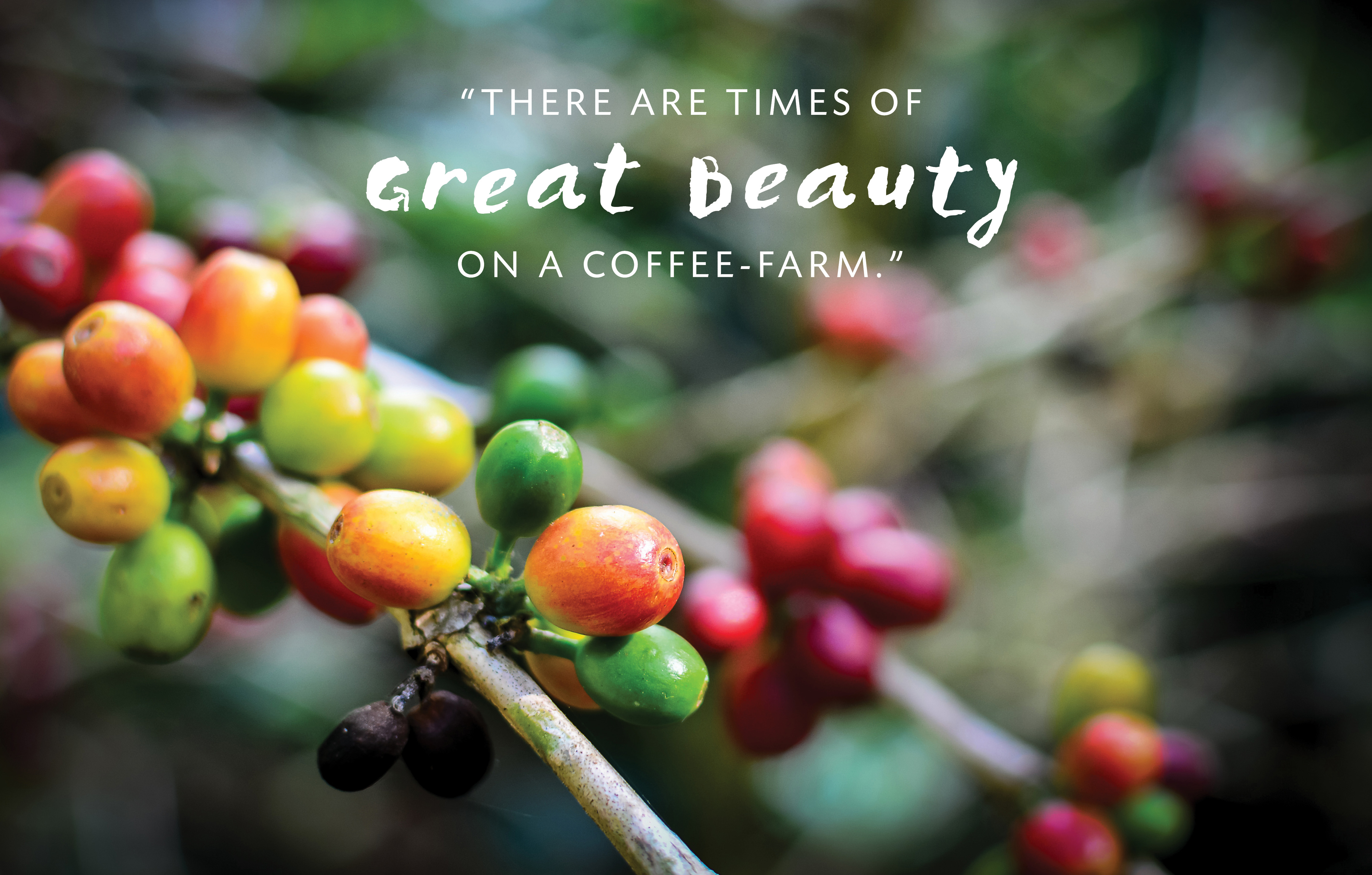
From “Out of Africa” by Isak Dinsen: “There are times of great beauty on a coffee-farm. When the plantation flowered in the beginning of the rains, it was a radiant sight, like a cloud of chalk, in the mist and the drizzling rain, over six hundred acres of land. The coffee-blossom has a delicate slightly bitter scent, like the blackthorn blossom. When the field reddened with the ripe berries, all the women and the children, whom they call the Totos, were called out to pick the coffee off the trees, together with the men; then the wagons and carts brought it down to the factory near the river. Our machinery was never quite what it should have been, but we had planned and built the factory ourselves and thought highly of it. Once the whole factory burned down and had to be built up again. The big coffee-dryer turned and turned, rumbling the coffee in its iron belly with a sound like pebbles that are washed about on the seashore. Sometimes the coffee would be dry, and ready to take out of the dryer, in the middle of the night. That was a picturesque moment, with many hurricane lamps in the huge dark room of the factory, that was hung everywhere with cobwebs and coffee-husks, and with eager glowing dark faces, in the light of the lamps, round the dryer; the factory, you felt, hung in the great African night like a bright jewel in an Ethiope’s ear. Later on the coffee was hulled, graded and sorted, by hand, and packed in sacks sewn up with a saddler’s needle.
Then in the end in the early morning, while it was still dark, and I was lying in bed, I heard the wagons, loaded high up with coffee-sacks, twelve to a ton, with sixteen oxen to each wagon, starting on their way in to Nairobi railway station up the long factory hill, with much shouting and rattling, the drivers running beside the wagons. I was pleased to think that this was the only hill up, on their way, for the farm was a thousand feet higher than the town of Nairobi. In the evening I walked out to meet the procession that came back, the tired oxen hanging their heads in front of the empty wagons, with a tired little Toto leading them, and the weary drivers trailing their whips in the dust of the road. Now we had done what we could do. The coffee would be on the sea in a day or two, and we could only hope for good luck at the big auction-sales in London.”
And upon having read the above, this from Diego Barcello, who has been involved with coffee growing since his birth: “That is an awesome description of coffee farming. Although, this description was a reality something like 30 years ago in Brazil. Since then they have modernized the coffee production much more. Some parts of this description I identify with my childhood, but some sounds like my father’s childhood times.”




